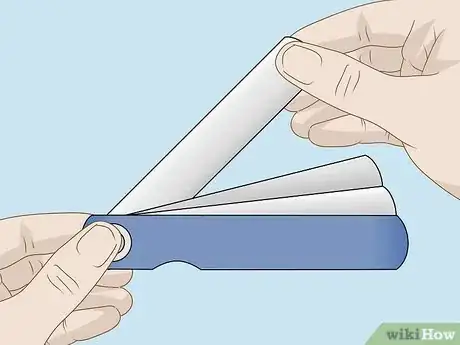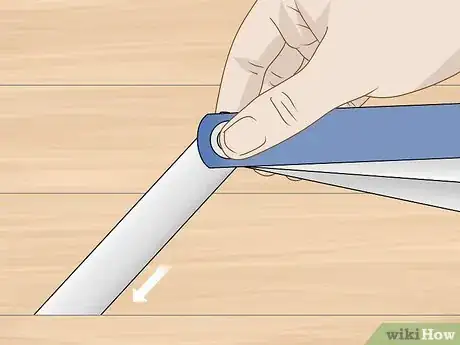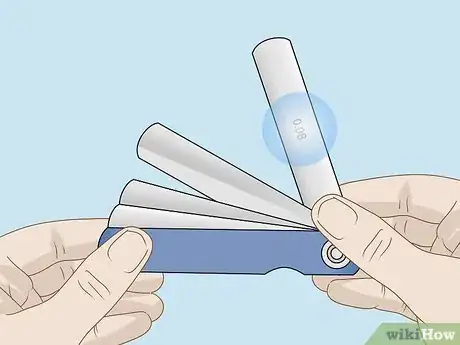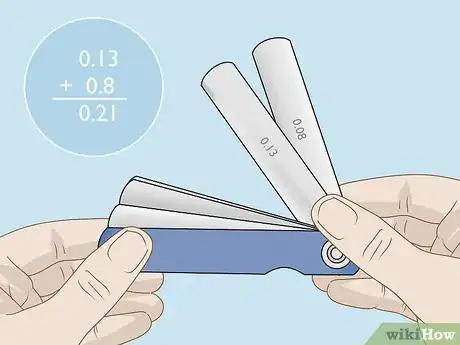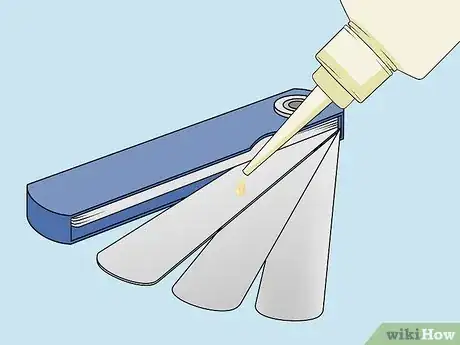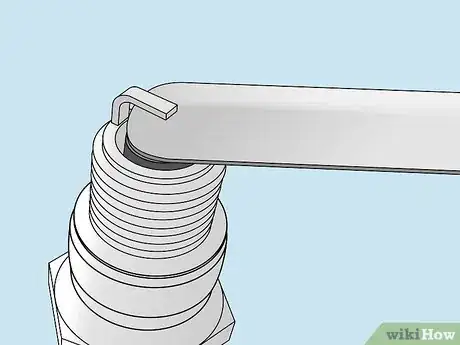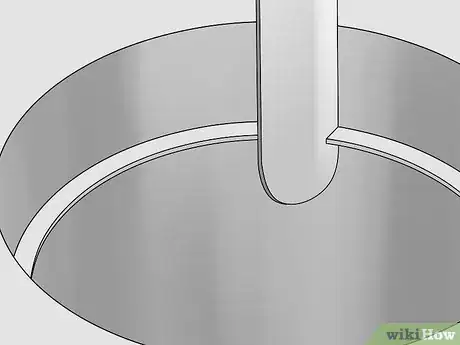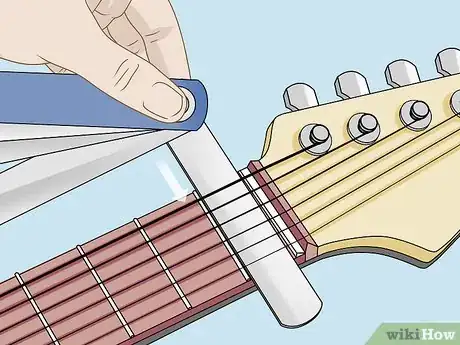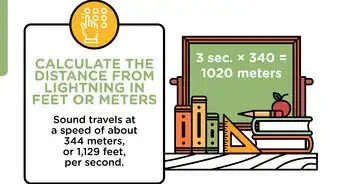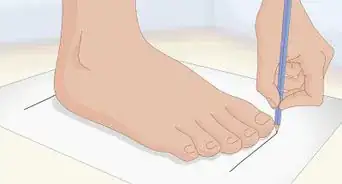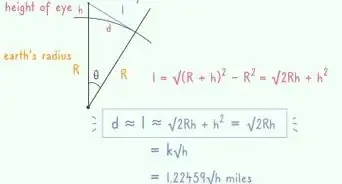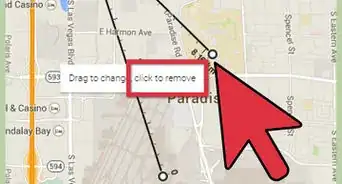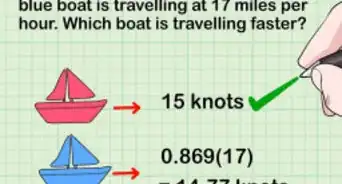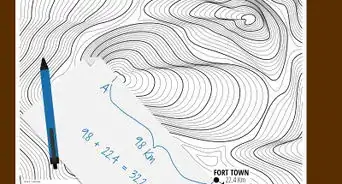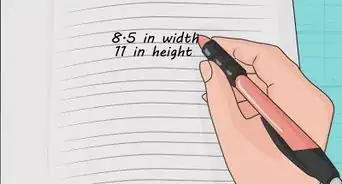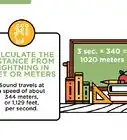This article was co-authored by wikiHow staff writer, Hunter Rising. Hunter Rising is a wikiHow Staff Writer based in Los Angeles. He has more than three years of experience writing for and working with wikiHow. Hunter holds a BFA in Entertainment Design from the University of Wisconsin - Stout and a Minor in English Writing.
There are 7 references cited in this article, which can be found at the bottom of the page.
This article has been viewed 62,899 times.
Learn more...
Feeler gauges are thin metal pieces that are used to measure narrow gaps in either hundredths of a millimeter or thousandths of an inch. When you use a feeler gauge, all you need to do is slide one of them into the gap you’re measuring and then look at the measurement printed on it. Feeler gauges are used to measure multiple items, such as spark plug gaps, piston rings, and guitar string height.
Steps
Using a Feeler Gauge
-
1Choose a feeler gauge you think will fit in the gap. Feeler gauges usually come in a set of 20-30 attached together by a pivot point. Look for one of the gauges that seems like it will fit into the gap and rotate it on the pivot point to “unfold” it from the set. Hold the feeler gauge at the pivot point to prevent it from folding back into the rest of the set.[1]
- You can buy feeler gauges from your local hardware store.
- Feeler gauges are often referred to as “blades” or “leaves.”
- You can also remove the feeler gauge from the rest of the set if you need to reach it into a hard-to-reach spot.
-
2Slide the gauge into the gap you’re measuring to check for friction. Use minimal force to push the gauge into the gap. If it doesn’t slide into the gap, try using the next gauge down to check. You should feel a small amount of friction when you insert the gauge, but not so much that it’s difficult to remove.[2]
- Don’t try to force a feeler gauge into a gap that’s too small since you could damage the parts or bend the gauge.
- Your feeler gauge will either have a consistent thickness or a tapered end that gets thinner. If you have a tapered feeler gauge, the thinnest section is the actual measurement.
- If the feeler gauge gets stuck in the gap, spray a lubricant like WD-40 onto it so it can slide out easily.
Tip: To get an idea of how much friction you should feel, put a sheet of paper between 2 magazines and pull it out. You should feel the same amount of friction when you slide the feeler gauge in the gap.[3]
Advertisement -
3Pull out the gauge and insert the next size up if you don't feel friction. If you don’t feel any friction, then the gauge is too thin and you need to try the next size up. Rotate the set on the pivot point to “unfold” it it and choose another size. Try to fit it into the gap just as you did before.
-
4Use 2 feeler gauges simultaneously if you can't find the right fit. If none of your feeler gauges are large enough to fit in the gap, then stack 2 of the gauges on top of each other. Slide both gauges into the gap to see if they fit. If they do, you can add their measurements together to calculate the gap width.
-
5Read the measurement printed on the gauge to determine the gap size. Once you find a feeler gauge that has friction when you put it into the gap, pull it out and look at the thickness measurement listed on the side. Check the label on the side of the gauge to see if it’s listed in thousandths of an inch or hundredths of a millimeter.[4]
- Usually, thousandths of an inch are listed with 3 numbers after a decimal point and hundredths of a millimeter have 2 numbers after a decimal point.
- Some feeler gauges will have both measurements printed on them. At least one of the measurements will be labeled so you know which one’s which.
-
6Add the measurements together if you used multiple feeler gauges. If you had to use multiple feeler gauges to fit in the gap, then add their measurements together to get the gap thickness. For example, if you stacked feeler gauges that were 0.008 and 0.013 inches (0.20 and 0.33 mm), then the thickness of the gap is 0.021 inches (0.53 mm) thick.
-
7Oil the feeler gauges after using them to prevent rust and sticking. Put a bead-sized amount of motor oil on a shop cloth or a paper towel and wipe the feeler gauges. Spread the oil over all of the gauges in the set with the shop cloth, opening and closing them so each gauge gets a thin coat of oil.[5]
- Oil helps the feeler gauges move freely so they don’t get caught in gaps.
- If you don’t oil the feeler gauges when you’re finished using them, be sure to oil them before the next time you use them so they don’t get stuck in the gap you’re measuring.
Measuring Items with a Feeler Gauge
-
1Measure the gap between the electrodes on a spark plug. Locate the curved metal bar on one end of your spark plug, also known as the ground electrode. Underneath the metal bar is a small cylindrical rod called the central electrode. Put the feeler gauge in the gap between the ground and central electrodes so you can find the measurement. Compare the measurement to specifications of your vehicle, and adjust the gap if you need to.[6]
- Many spark plug gaps need to be between 0.028–0.060 inches (0.71–1.52 mm).
- If your spark plugs don’t have a correctly-sized gap, it can lead to engine misfire, low gas mileage, or even loss of power.
-
2Use feeler gauges to find the gap distances on piston rings. Piston rings inside engine cylinders have small gaps in them that help the piston move smoothly. Place the piston ring into the cylinder and use the piston to push it down at least 1⁄2 inch (1.3 cm) to make sure it’s square. Feed the end of a feeler gauge in the gap on the ring, and continue testing gauges until you find one that fits with a little friction. Compare the measurement to the gap limit based on the specifications for your engine.[7]
- Don’t measure the gap on a piston ring while it’s outside of the cylinder since it won’t be accurate.
- If the gap in the ring is too small, use a file to grind the ends down until it has the gap size you need.
- A piston ring has a gap that’s too large will reduce the efficiency of your engine.
Tip: The gap size of the piston rings depends on the engine or vehicle that you’re working on. Check the user’s manual to determine how much of a gap you can leave.
-
3Find the string height of a guitar between the E-strings and the 1st fret. Hold your guitar in playing position so you can get an accurate measurement. Position a feeler gauge so it’s on top of the 1st fret bar at the top of the guitar’s neck and under the thickest string, or low E. Write down your measurement before checking the height of the thinnest string, or high E, at the 1st fret.[8]
- To get the best tone and make it easier to play on an electric or acoustic guitar, the top string should have a height of 0.030 inches (0.76 mm) and the bottom string should be 0.015 inches (0.38 mm).
Warnings
- Don’t force the feeler gauges into the gaps if they don’t fit since you could bend them or damage the parts you’re measuring.[9]⧼thumbs_response⧽
Things You’ll Need
- Feeler gauges
- Shop cloth or paper towel
- Motor oil
References
- ↑ https://careertrend.com/how-4962698-use-feeler-gauge.html
- ↑ https://careertrend.com/how-4962698-use-feeler-gauge.html
- ↑ https://youtu.be/MPUhBGF1dyY?t=46
- ↑ https://www.thomasnet.com/articles/instruments-controls/all-about-feeler-gauges-definition-sizes-and-uses/
- ↑ https://youtu.be/eq-3zBA4fso?t=141
- ↑ https://youtu.be/q0cl_YrfjMc?t=54
- ↑ https://youtu.be/eeliqbj5DgQ?t=66
- ↑ https://www.stewmac.com/video-and-ideas/online-resources/neck-building-and-repair-and-setup/string-action-gauge-instructions/
- ↑ https://careertrend.com/how-4962698-use-feeler-gauge.html
